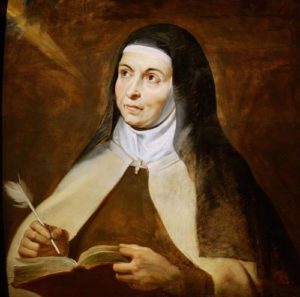Podcast: Play in new window | Download (Duration: 29:24 — 20.3MB) | Embed
Subscribe: Apple Podcasts | Spotify | Amazon Music | Android | Pandora | iHeartRadio | JioSaavn | Podchaser | Gaana | Podcast Index | Email | TuneIn | Deezer | Anghami | RSS | More

Awareness of the Presence of Christ – The Life of St. Teresa of Avila – Beginning to Pray with Dr. Anthony Lilles
Dr. Anthony Lilles and Kris McGregor discuss Chapter 27 of the work by St. Teresa of Avila. They explore St. Theresa’s profound spiritual experiences, particularly her visions and locutions, and how they relate to the stages of the spiritual life. In addition, they discuss St. Theresa’s humility in submitting her experiences to her confessor and the transformative effects these experiences have on the soul.
Dr. Lilles draws parallels between Theresa’s visions and experiences of other spiritual writers, comparing the deep personal encounter with Christ they represent, including the distinctions between various levels of spiritual awareness, such as the prayer of quiet and the prayer of union, and how they manifest in the soul’s relationship with God.
While these extraordinary experiences are not necessary for spiritual growth, they can profoundly impact the soul and its journey towards God.
For more episodes in this series: The Life of St. Teresa of Avila; with Dr. Anthony Lilles
For an audio version of the book: “The Life of St. Teresa of Jesus” by St. Teresa of Avila
For other audio recordings of various spiritual classics, you can visit the Discerning Hearts Spiritual Classics page.

Discerning Hearts reflection questions for this episode:
- Exploring Spiritual Experiences: How do St. Teresa of Avila’s visions and locutions deepen our understanding of spiritual encounters with God?
- Submission to Spiritual Authority: What lessons can we learn from St. Teresa’s humility in submitting her spiritual experiences to her confessor?
- Transformative Encounters: How do encounters with Christ, like those described by St. Teresa, impact the soul and its journey towards God?
- Levels of Spiritual Awareness: What distinctions can we draw between different levels of spiritual awareness, such as the prayer of quiet and the prayer of union, and how they manifest in the soul’s relationship with God?
An excerpt from Chapter 27, discussed in this episode:
“At the end of two years spent in prayer by myself and others for this end, namely, that our Lord would either lead me by another way, or show the truth of this,—for now the locutions of our Lord were extremely frequent,—this happened to me. I was in prayer one day,—it was the feast of the glorious St. Peter —when I saw Christ close by me, or, to speak more correctly, felt Him; for I saw nothing with the eyes of the body, nothing with the eyes of the soul. He seemed to me to be close beside me; and I saw, too, as I believe, that it was He who was speaking to me. As I was utterly ignorant that such a vision was possible, I was extremely afraid at first, and did nothing but weep; however, when He spoke to me but one word to reassure me, I recovered myself, and was, as usual, calm and comforted, without any fear whatever. Jesus Christ seemed to be by my side continually, and, as the vision was not imaginary, I saw no form; but I had a most distinct feeling that He was always on my right hand, a witness of all I did; and never at any time, if I was but slightly recollected, or not too much distracted, could I be ignorant of His near presence.
I went at once to my confessor, in great distress, to tell him of it. He asked in what form I saw our Lord. I told him I saw no form. He then said: “How did you know that it was Christ?” I replied, that I did not know how I knew it; but I could not help knowing that He was close beside me,—that I saw Him distinctly, and felt His presence,— that the recollectedness of my soul was deeper in the prayer of quiet, and more continuous,—that the effects thereof were very different from what I had hitherto experienced,—and that it was most certain. I could only make comparisons in order to explain myself; and certainly there are no comparisons, in my opinion, by which visions of this kind can be described. Afterwards I learnt from Friar Peter of Alcantara, a holy man of great spirituality,—of whom I shall speak by and by,—and from others of great learning, that this vision was of the highest order, and one with which Satan can least interfere; and therefore there are no words whereby to explain,—at least, none for us women, who know so little: learned men can explain it better.
For if I say that I see Him neither with the eyes of the body, nor with those of the soul,—because it was not an imaginary vision,—how is it that I can understand and maintain that He stands beside me, and be more certain of it than if I saw Him? If it be supposed that it is as if a person were blind, or in the dark, and therefore unable to see another who is close to him, the comparison is not exact. There is a certain likelihood about it, however, but not much, because the other senses tell him who is blind of that presence: he hears the other speak or move, or he touches him; but in these visions there is nothing like this. The darkness is not felt; only He renders Himself present to the soul by a certain knowledge of Himself which is more clear than the sun. I do not mean that we now see either a sun or any brightness, only that there is a light not seen, which illumines the understanding so that the soul may have the fruition of so great a good. This vision brings with it great blessings.”
Anthony Lilles, S.T.D. is an associate professor and the academic dean of Saint John’s Seminary in Camarillo as well as the academic advisor for Juan Diego House of Priestly Formation for the Archdiocese of Los Angeles. For over twenty years he served the Church in Northern Colorado where he joined and eventually served as dean of the founding faculty of Saint John Vianney Theological Seminary in Denver. Through the years, clergy, seminarians, religious and lay faithful have benefited from his lectures and retreat conferences on the Carmelite Doctors of the Church and the writings of St. Elisabeth of the Trinity.

